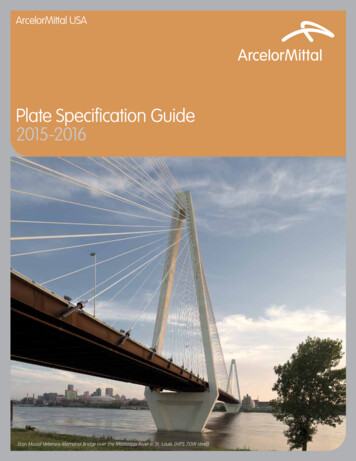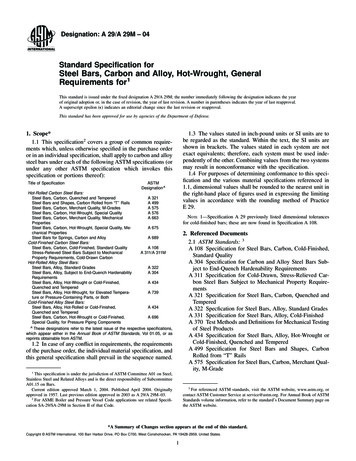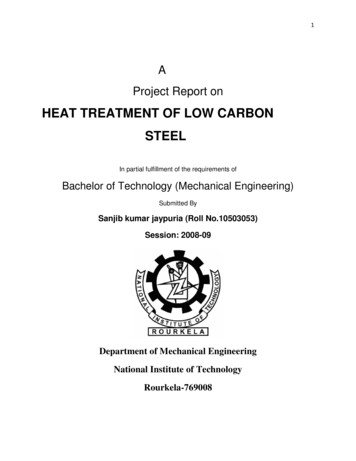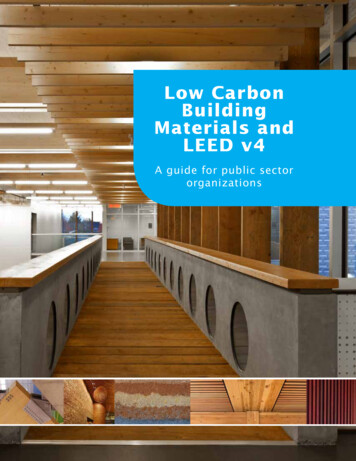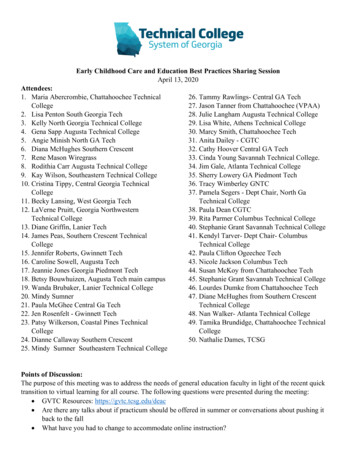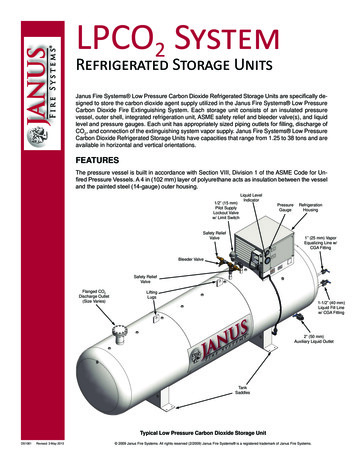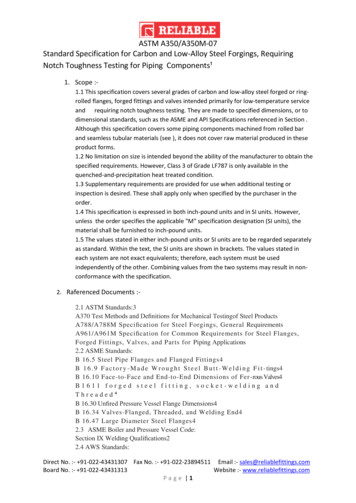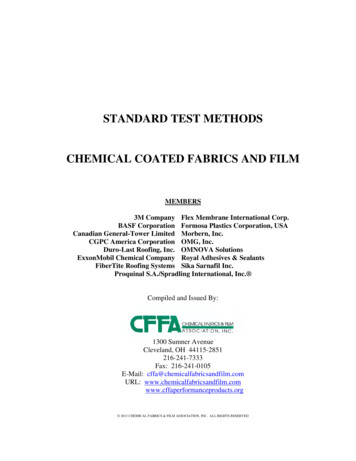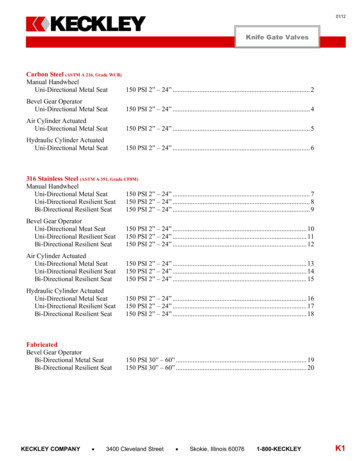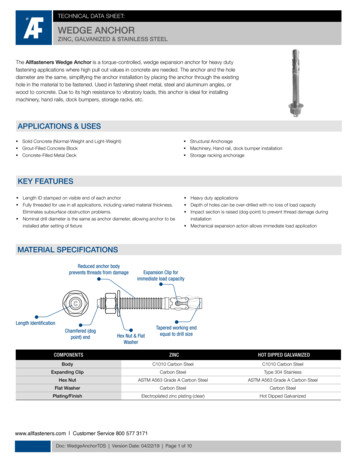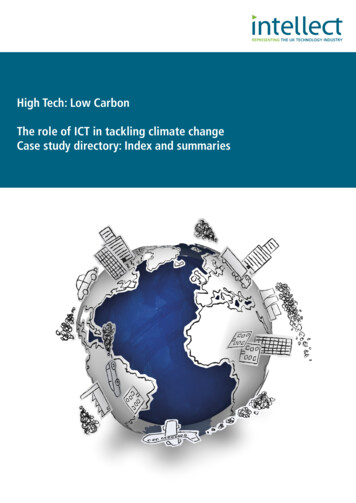
Transcription
High Tech: Low CarbonThe role of ICT in tackling climate changeCase study directory: Index and summariesManaged Print ServicesA Business Tool for the Information Age
ContentsIntroduction03Case Study IndexThese case studies are indexed in three ways.Index 1 – by TitleThe first index is simply a list of case studies in alphabetical order of title.04Index 2 – by SectorThe second index is sectoral and groups the case studies under the sectors thatthey most readily apply to. Sectors include agriculture, buildings, consumer electronics,energy supply, forestry, ICT, public sector and transport. Some case studies are trulycross-sectoral and are listed accordingly.06Index 3 – by Technology TypeThe third index lists the case studies by type of technology and reflects the structureof our report "High Tech: Low Carbon – the role of technology in tackling climatechange". Those case studies listed under best practice illustrate improvements we havemade to our own products and services through the three phases of design, manufactureand use. The next section includes the rest of the case studies which all demonstrate howthe intelligent application of technology across other sectors is delivering energy savingsand emissions reductions over the wider economy. These case studies explore enhancing,enabling and transforming technologies in turn. These categories are not definitive;many technologies apply to more than one category.08Case Study SummariesShort summaries of the case studies within Intellect’s Case Study Library. All illustrate waysin which the technology sector is either delivering improvements in the efficiency of its productsand services or demonstrating how the intelligent use of technology is delivering measurableemissions reductions across the wider economy. Full case studies are available in most cases.11For full case studies please visit www.intellectuk.org/casestudies02 High Tech: Low Carbon: The role of ICT in tackling climate change - Case study directory: Indexes and summaries
IntroductionIn February 2008, Intellect published a report,High Tech: Low Carbon, which was effectively astatement for the technology sector*. It explored the critical role that technology can playin reducing energy use across the economy. Itstarted by examining the sector’s own productsand services and addressed a number of problems like proliferation, standby and rapid obsolescence. The report then went on to explorethe ways that technology helps other sectors tobecome more efficient, firstly by enhancingexisting processes to make them more efficient(so that people can do the same things theyalready do but more efficiently) secondly byenabling new processes (so that people can dothings in different ways) and thirdly, by transforming behaviour through virtualisation (doingdifferent things altogether and creating new,low-carbon business models). It concludes thatinnovation and the intelligent use of technologyprovide two possible solutions to climatechange, and that everything possible must bedone to accelerate their development and implementation.The report was accompanied by a number ofcase studies that provided evidence to back upthe points we were making. Since publication,this set of case studies has been expanded andnow comprises around a hundred differentexamples. This document effectively drawstogether all of our case studies into a singledigest. Each one is summarised into a shortparagraph. Longer versions can be found onIntellect’s website.For further information contact:Emma FryerHead of Climate Change ProgrammesIntellectRussell Square House10-12 Russell SquareLondon WC1B 5EET 01609 772 137M 07714 803 650E emma.fryer@intellectuk.orgW www.intellectuk.org*For the purposes of this document, the technology sector comprises the Information andCommunications Technologies (ICT) and Consumer Electronics (CE) sectors, including electronics manufacturing, defence and spacerelated IT. These broad titles, however, disguise a wide range of environmental offeringsthat include, to name but a few, virtual conferencing and collaboration tools, satellite broadcasting systems, intelligent transport systemsincluding transport telematics, logistics andsatellite navigation tools, building and energymanagement systems, photovoltaics, in-silicomodelling, testing and CAD and carbon auditing and accounting systems.The case studies enclosed are also indexed inthree different ways, to make them as accessible and useful as possible: by alphabetical order of title, by sector and by technology type(see above).High Tech: Low Carbon: The role of ICT in tackling climate change - Case study directory: Indexes and summaries03
Index 1: Intellect case studies by title1E: Nightwatchman and Peterborough City CouncilUser management technologies – networks11ACIS: The BridgeIntelligent Transport systems11AMD: PowerNow TechnologyProcessor (chip) efficiency11Apsys: SIMLOG and system analysisMonitoring and measuring technologies/logistics11Atkins: Transport modeling in ScotlandOptimising transport planning11BAE Systems: IVHMRound-the-clock MOT for military vehicles11Best Foot Forward: Scenarios in SunderlandMeasuring and modelling carbon impacts12BT: EdinburghOptimising IT Infrastructure efficiencyBT: Electronic ConferencingVirtual conferencing12BT: Flexible Location Working in WestminsterMobile Working12Capula: Real Time Emissions MonitoringEmissions monitoring for the power supply sector12Cisco: TelePresenceVideo conferencing13Co-op Future Travel: HomeshoringTeleworking13DEFRA: Lion HouseOptimising energy performance in buildings13Dell: Liverpool Womens NHS TrustOptimising IT efficiency through virtualization13Dell: Mobile Working in HealthcareMobile working13Dynamic Demand: Stabilising energy demandEnergy reduction/intelligent intervention13eCare in Scotland: HEARTMobile working14EDS: Holistic infrastructure managementOptimising efficiency of ICT architectures14Eneco: Energy conversion chipProcessor (chip) design14Epson: Digital printingPrinting technology14Evident Europe: Digital Evidence SealsEnabling paperless working14Fujitsu Siemens Computers: Data centre energy savingsImproving data centre energy efficiency14Fujitsu: Environmentally Conscious SolutionsEvaluating efficiency gains through use of ICT15Fujitsu: Life cycle comparisonLife cycle analysis of desktop and laptop PCs15HP: Dynamic Smart CoolingData centre efficiency through better cooling15HP: Virtual Collaboration SystemRemote working15IBM: Cooperative GroupOptimising efficiency of ICT15IBM: DONG Energy – Intelligent GridSmarter grids16IBM: ENBW - changing behaviour by real-time pricingProviding energy information to domestic customers16IBM: Guangdong Dapeng LNG – New Energy SupplyEfficient production of LNG16IBM: ICT and office optimisationImproving efficiency in office processes16IBM: Modelling for the Nature ConservancyIn silico Modelling16IBM: Pacific NorthwestManaging Energy Demand17IBM: Recycling silicon for solar powerEnabling renewable generation17IBM: Road chargingOptimising transport efficiencies17IBM: US Postal ServiceIntegrated Network Modelling17IBM: Virtualisation in FlintshireOptimising efficiency of ICT architecture17Intel and ING: Remote PC managementUser management technologies – networks18Intel and Telefonica: IT TroubleshootingVirtualised IT troubleshooting18IPL: MIDAS and ATMTelematics for the Highways Agency18Logica: Stamp Down our CarbonReducing corporate carbon footprint1804 High Tech: Low Carbon: The role of ICT in tackling climate change - Case study directory: Indexes and summaries
Index 1: Intellect case studies by titleLysanda: EcoLogMeasuring vehicle emissions18Merryl Lynch: Data Centre outsourcingImproving data centre energy efficiency18Microlise: Vehicle telematics and trackingIntelligent transport systems19Microsoft and Brockenhurst College: ICT efficiencyImproving the efficiency and performance of ICT19Microsoft and Wakefield: WorksmartImproving efficiency through software19Microsoft and Westminster: Member portalsDelivering enhanced services and reducing emissions19Microsoft and Wise Group: Paperless officeDelivering a paperless office with ICT19Microsoft: Perth and KinrossVirtualising IT Infrastructures19Microsoft: SloughVirtualising IT Infrastructures20MiX Telematics: Oxford BusesEfficiency improvements through telemetry20Nokia: Charger alertsStandby/power supply efficiency20Nokia: Logistics and resource managementOptimising transport efficiency through logistics20Nokia: Minimising mobile phone packagingOptimising packaging for mobile phones21NXP Semiconductors: power converter efficiencyPower supply efficiency21OSIsoft: Kodak ParkEnergy management systems21Oyster Card: Transport for LondonEncouraging uptake of public transport21Philips: Efficient highway lightingEfficient lighting solutions for transport infrastructure21Philips: Efficient lighting – office & homeEfficient lighting solutions21Philips: Internet information and entertainmentReducing energy demand through virtualisation22Philips: LED lighting for the National TheatreSmart building: lighting solutions22Philips: LED Lighting for the O2 ArenaEfficient lighting solutions for the entertainment industry22Philips: SmartPowerAutomatic switch-off for TVs22QinetiQ: Stealth TurbinesRemoving barriers to renewable generation22Sharp: Super Green initiativeManufacturing efficiency and life cycle assessment22Sharp: Super Green Kameyama plantManufacturing process efficiency23Siemens: BACSMulti-building energy management23Siemens: Document management systemsFacilitating paperless working and carbon trading23Siemens: Intelligent algorithms for smart gridsOptimising renewable generation23Siemens: Lighting solutions for BudapestLighting solutions for transport infrastructure23Siemens: Making Buildings IntelligentSmart buildings: Building management systems23Smart Services: Changing agricultural practiceRemote sensing24Sony: Best in class TV standbyImproving energy efficiency of TVs in standby24Sun Microsystems: Black BoxOptimising data centre efficiency and flexibility24Sun Microsystems: Data centre consolidationImproving data centre efficiency through consolidation24Tandberg: Video conferencing for VodafoneVideo conferencing24Tesco: Building Management SystemsImproving building efficiency through ICT25Thales: NuVa CollaborationRemote working25Thales: Smart Container TrackingIntelligent transport: shipper container tracking25Toshiba: Factor TEco design to balance performance and environment25Wyse: Thin client solutions for Reed Managed ServicesImproving energy efficiency of organisational IT25Wyse & Queen Margaret University: Holistic ICTOptimising ICT efficiency26Xerox: Carbon footprint calculatorMonitoring and measuring technologies26Xerox: Designing for energy efficiencyEco-design26Xerox: Electronic reusable paper - GyriconEnabling paperless working26High Tech: Low Carbon: The role of ICT in tackling climate change - Case study directory: Indexes and summaries05
Index 2: Intellect case studies by sectorThis index is sectoral and groups the case studies under the sectors that they most readily apply to. Sectors include agriculture,buildings, consumer electronics, energy supply, forestry, ICT, public sector and transport. Some case studies are truly cross-sectoral andare listed accordingly.Sector/applicationCase study titleAgricultureSmart Services: Changing agricultural practice24BuildingsDynamic Demand: Stabilising energy demand13BuildingsIBM: ICT and office optimisation16BuildingsOSIsoft: Kodak Park21BuildingsPhilips: Efficient lighting in offices and homes21BuildingsPhilips: Internet information and entertainment22BuildingsPhilips: LED lighting for the National Theatre22BuildingsPhilips: LED Lighting for the O2 Arena22BuildingsSiemens: BACS – Multi-building energy management23BuildingsSiemens: Making Buildings Intelligent23BuildingsTesco: Building Management Systems25Consumer ElectronicsNokia: Charger alerts20Consumer ElectronicsNokia: Minimising mobile phone packaging21Consumer ElectronicsPhilips: SmartPower22Consumer ElectronicsSharp: Super Green initiative22Consumer ElectronicsSharp: Super Green Kameyama plant23Consumer ElectronicsSony: Best in class TV standby24Consumer ElectronicsToshiba: Factor T25Cross-sectoralApsys: SIMLOG and system analysis11Cross-sectoralBest Foot Forward: Scenario modeling12Cross-sectoralEvident Europe: Digital Evidence Seals14Cross-sectoralFujitsu: Environmentally Conscious Solutions15Cross-sectoralIBM: ICT and office optimisation16Cross-sectoralIBM: Modelling for the Nature Conservancy16Cross-sectoralLogica: Stamp Down Our Carbon18Cross-sectoralSiemens: Document management systems for emissions trading23Cross-sectoralXerox: Carbon footprint calculator26Cross-sectoralXerox: Electronic reusable paper - Gyricon26Energy supplyQinetiQ: Stealth Turbines22Energy supplyCapula: Real time emissions monitoring12Energy supplyIBM: DONG Energy – Intelligent Grid16Energy supplyIBM: ENBW and changing behaviour by real-time pricing16Energy supplyIBM: Guangdong Dapeng LNG – New Energy Supply16Energy supplyIBM: Pacific Northwest – managing energy demand17Energy supplyIBM: Recycling silicon for solar power17Energy supplySiemens: Document management systems for emissions trading23Energy supplySiemens: Intelligent algorithms for smart grids23ForestryNokia: Logistics and resource management20ICT1E: Nightwatchman and Peterborough City Council11ICTAMD: PowerNow Technology11ICTBT: Edinburgh1206 High Tech: Low Carbon: The role of ICT in tackling climate change - Case study directory: Indexes and summaries
Index 2: Intellect case studies by sectorICTDell: Liverpool Women’s NHS Trust13ICTEDS: Holistic infrastructure management14ICTEneco: Energy conversion chip14ICTEpson: Digital printing14ICTFujitsu Siemens Computers: Data centre energy savings14ICTFujitsu: Life cycle comparison15ICTHP: Dynamic Smart Cooling15ICTIBM: Cooperative Group15ICTIBM: Virtualisation in Flintshire17ICTIntel and ING: Remote PC management18ICTIntel and Telefonica: IT Troubleshooting18ICTMerryl Lynch: Data Centre outsourcing18ICTMicrosoft and Brockenhurst College: ICT efficiency19ICTMicrosoft and Wakefield: Worksmart19ICTMicrosoft and Westminster: Member portal19ICTMicrosoft and Wise Group: Paperless office19ICTMicrosoft: Perth and Kinross19ICTMicrosoft: Slough20ICTNXP Semiconductors: Power converter efficiency21ICTSun Microsystems: Black Box24ICTSun Microsystems: Data centre consolidation24ICTWyse and Queen Margaret University: Holistic ICT26ICTWyse: Thin client solutions for Reed Managed Services25ICTXerox: Designing for energy efficiency26Public sector1E: Nightwatchman and Peterborough City Council11Public sectorMicrosoft and Brockenhurst College: ICT efficiency19Public sectorMicrosoft and Wakefield: Worksmart19Public sectorMicrosoft and Westminster: Member portal19Public sectorWyse and Queen Margaret University: Holistic ICT26RetailMicrolise and Tesco: Vehicle telematics and tracking19RetailTesco: Building Management Systems25TransportACIS: The Bridge11TransportAtkins: Transport modeling in Scotland11TransportBAE Systems: IVHM11TransportIBM: US Postal Service – Integrated Network Modelling17TransportIBM: Road charging17TransportIPL: Telematics for the Highways Agency18TransportLysanda: EcoLog18TransportMicrolise and Tesco: Vehicle telematics and tracking19TransportMiX Telematics: Oxford Buses20TransportNokia: Logistics and resource management20TransportOyster Card: Transport for London21TransportPhilips: Efficient highway lighting21TransportSiemens: Lighting solutions for Budapest23TransportThales: Smart Container Tracking25High Tech: Low Carbon: The role of ICT in tackling climate change - Case study directory: Indexes and summaries07
Index 2: Intellect case studies by sectorTransport substitutesBT Electronic ConferencingTransport SubstitutesBT: Flexible Location Working in WestminsterTransport substitutesCisco: TelePresenceTransport substitutesCo-op Future Travel: HomeshoringTransport substitutesDell: Mobile Working in HealthcareTransport substituteseCare in Scotland: HEARTTransport substitutesHP: Virtual Collaboration SystemTransport substitutesTandberg: Videoconferencing for VodafoneTransport substitutesThales: NuVa Collaboration solutionsIndex 3: Intellect case studies by technology typeThis third index lists the case studies by type of technology and reflects the structure of our report ‚High Tech: Low Carbon – the roleof technology in tackling climate change‛. Those case studies listed under best practice illustrate improvements we have made to ourown products and services through the three phases of design, manufacture and use. The next section includes the rest of the casestudies which all demonstrate how the intelligent application of technology across other sectors is delivering energy savings andemissions reductions over the wider economy. These case studies explore enhancing, enabling and transforming technologies in turn.These categories are not definitive; many technologies apply to more than one category.Section 1: Best Practice These case studies listed under best practice illustrate improvements we have made to our own products andservices through the three phases of design, manufacture and use.TitleDescriptionAMD: PowerNow TechnologyProcessor (chip) efficiency11BT: EdinburghOptimising IT Infrastructure efficiency12Dell: Liverpool Womens NHS TrustOptimising IT efficiency through virtualization13Eneco: Energy conversion chipProcessor (chip) design14Fujitsu Siemens Computers: Data centre efficiencyImproving data centre energy efficiency14Fujitsu: Life cycle comparisonLife cycle analysis of desktop and laptop PCs15HP: Dynamic Smart CoolingData centre efficiency through better cooling15IBM: Cooperative GroupOptimising efficiency of ICT15IBM: Virtualisation in FlintshireOptimising efficiency of ICT architecture17Intel and ING: Remote PC managementUser management technologies – networks18Intel and Telefonica: IT TroubleshootingVirtualising IT troubleshooting18Logica: Stamp down our carbonReducing corporate carbon emissions18Merryl Lynch: Data Centre outsourcingImproving data centre energy efficiency18Microsoft and Brockenhurst College: ICT efficiencyImproving the efficiency and performance of ICT19Microsoft and Wakefield: WorksmartImproving efficiency through software19Microsoft and Westminster: Member portalsDelivering enhanced services and reducing emissions19Microsoft and Wise Group: Paperless officeDelivering a paperless office with ICT19Microsoft: Perth and KinrossVirtualising IT Infrastructures19Microsoft: SloughVirtualising IT Infrastructures20Nokia: Charger alertsStandby/power supply efficiency20Nokia: Minimising mobile phone packagingOptimising packaging for mobile phones20NXP Semiconductors: power converter efficiencyPower supply efficiency21Philips: SmartPowerAutomatic switch-off for TVs2208 High Tech: Low Carbon: The role of ICT in tackling climate change - Case study directory: Indexes and summaries
Index 3: Intellect case studies by technology typeSharp: Super Green initiativeManufacturing efficiency and life cycle assessment22Sharp: Super Green Kameyama plantManufacturing process efficiency23Sony: Best in class TV standbyImproving energy efficiency of TVs in standby24Sun Microsystems Black BoxImproving data centre energy efficiency24Sun Microsystems: Data centre consolidationImproving data centre efficiency through consolidation24Toshiba: Factor TEco-design to balancing performance and environment25Wyse: Thin client solutions for ReedImproving energy efficiency of organisational IT25Wyse: Queen Margaret University: Holistic ICTUsing ICT to improve efficiency and enhance learning26Xerox: Designing for energy efficiencyEco-design26Section 2 – Demonstrating how technology can deliver efficiency savings across the wider economyThese case studies all demonstrate how the intelligent application of technology across other sectors is delivering energysavings and emissions reductions over the wider economy. These case studies explore enhancing, enabling andtransforming technologies in turn. These categories are not definitive; many technologies apply to more than onecategory.2A: Enhancing TechnologiesEnhancing technologies enhance existing processes – they help us do the thing we already do but more efficiently.1E: Nightwatchman and Peterborough City CouncilUser management technologies - networks11ACIS: The BridgeIntelligent Transport systems11Apsys: SIMLOG and system analysisMonitoring and measuring technologies/logistics11Atkins: Transport modelling in ScotlandOptimising transport planning11Dynamic Demand: Stabilising energy demandEnergy reduction/intelligent intervention13EDS: Holistic infrastructure managementOptimising efficiency of ICT architectures14Epson: Digital printingPrinting technology14Fujitsu: Environmentally Conscious SolutionsEvaluating efficiency gains through use of ICT15IBM: ENBW – changing behaviour by real-time pricing Providing energy information to domestic customers16IBM: Guangdong Dapeng LNG – New Energy SupplyEfficient production of LNG16IBM: ICT and office optimisationImproving efficiency in office processes16IBM: Pacific NorthwestManaging Electricity Demand17IBM: US Postal ServiceIntegrated Network Modelling17IBM: Road chargingOptimising transport efficiencies17IPL: MIDAS and ATMTelematics for the Highways Agency18Lysanda: EcoLogMeasuring vehicle emissions18Microlise: Vehicle telematics and trackingIntelligent transport systems19MiX Telematics: Oxford BusesEfficiency improvements through telemetry20Nokia: Logistics and resource managementOptimising transport efficiency through logistics20OSloft: Kodak ParkEnergy management systems21Philips: Efficient highway lightingMore efficient lighting for highways21Philips: Efficient lighting for offices and homesMore efficient lighting for buildings and transport21Philips: LED lighting for the National TheatreSmart building: lighting solutions22Philips: LED Lighting for the O2 ArenaLighting solutions for buildings22Siemens: BACSMulti-building energy management23Siemens: Lighting solutions for BudapestLighting solutions for transport infrastructure23Siemens: Making buildings intelligentSmart buildings: Building management systems23Tesco: Building Management SystemsOptimising building efficiency through ICT25Thales: Smart Container TrackingIntelligent transport: shipper container tracking25Xerox: Carbon footprint calculatorMonitoring and measuring technologies26High Tech: Low Carbon: The role of ICT in tackling climate change - Case study directory: Indexes and summaries09
Index 3: Intellect case studies by technology type2B: Enabling TechnologiesEnabling technologies enable new processes – the allow us to do things in different ways, yet achieve the same or betteroutcomes.BAE Systems: IVHMRound-the-clock MOT for military vehicles11Best Foot Forward: Scenario modelingMeasuring and modeling carbon impacts12Capula: Real Time Emissions MonitoringEmissions monitoring for the power supply sector12eCare in Scotland: HEARTMobile working14Evident Europe: Digital Evidence SealsEnabling paperless working14IBM: DONG Energy – Intelligent GridSmarter grids16IBM: Modelling for the Nature ConservancyIn silico modelling16IBM: Recycling silicon for solar powerEnabling renewable generation17Oyster Card: Transport for LondonEncouraging uptake of public transport21Philips: Internet information and entertainmentReducing energy demand through virtualisation22QinetiQ: Stealth TurbinesRemoving barriers to renewable generation22Siemens: Document management systemsFacilitating paperless working and carbon trading23Siemens: Intelligent algorithms for smart gridsOptimising renewable generation23Xerox: Electronic reusable paper - GyriconEnabling paperless working262C: Transforming Technologies – technologies that change what we do altogetherBT Electronic conferencingVirtual conferencing12BT: Flexible Location Working in WestminsterMobile Working12Cisco: TelePresenceVideo conferencing13Co-op Future Travel: HomeshoringTeleworking13Dell: Mobile Working in HealthcareMobile working13HP: Virtual Collaboration SystemRemote working15Smart Services: Changing agricultural practiceRemote sensing24Tandberg: Video-conferencing for VodafoneVideo conferencing24Thales: NuVa collaborative SolutionsRemote working25Full case studies available at www.intellectuk.org/casestudies10 High Tech: Low Carbon: The role of ICT in tackling climate change - Case study directory: Indexes and summaries
Case study summaries (alphabetical order of title)1E: Nightwatchman and Peterborough CityCouncilNightWatchman is a computer programme thatenables computers that are left on but not inuse to be switched of centrally, safely andremotely. Peterborough City Council has 4,500staff and estimated that 30% of PCs werebeing left on when not in use, costing theauthority between 40 and 60 per machine.Even after an education programme, machineswere still being left on because staff found ithard to differentiate between stand-by andoff-modes. The Authority recentlyimplemented the NightWatchman softwaresolution, supplied by 1E, across its entire ICTinfrastructure. It achieved a return oninvestment within 3 months, cost savings of 50,000 per annum and a reduction of 250tonnes of CO2 emissions per annum.Apsys: SIMLOG and system analysisWith much confusion over which systemarchitecture has the least life cycle cost andlowest carbon emissions, Apsys has developed anew model. Over the last 15 years APSYS hasdeveloped and supplied an Integrated LogisticSupport (ILS) software tool called SIMLOG. Themain functions of SIMLOG are maintenanceoptimisation and life cycle cost (LCC)assessment. What makes this new moduledifferent is that it calculates the carbonemissions of a system and its maintenance andenables users to identify which systemarchitecture and which maintenance optionshave the lowest carbon footprint and to selectthe most energy efficient option. Furthermore,it enables the carbon emissions for each optionto be costed per tonne, and provides a metricfor life cycle cost assessment.ACIS and The Bridge: Intelligent TransportSystemsACIS is implementing Intelligent TransportSystems in Dartford, UK to encourage the useof public transport. The system currently beingadopted provides residents with an electronicdisplay in their homes which tells them whenthe next bus will arrive. Buses also use TLP(traffic light priority) to improve speed throughtraffic lights and bottlenecks if necessary,improving reliability and regulating the service.Atkins: Transport Modelling in ScotlandAtkins has developed sophisticated modellingtools to enable transport planners and decisionmakers to identify and implement transportstrategies with the least environmental impact.These calculate operational emissions from thetransport network, using inputs from traditionaltransport models as well as taking into accountadditional factors such as local trips,behavioural change programmes and financialincentives. The tools are helping the ScottishGovernment to assess the effectiveness ofdifferent policy options in reducing thecontribution of transport to climate change.AMD: PowerNow! TechnologyAMD PowerNow! Technology is a powermanagement solution integrated into AMDOpteron processors that helps to reduce CPU(central processing unit) power consumption inservers by 15% and up to 40% at idle.Correspondingly, this also lowers the electricityconsumption of the cooling equipment. Theresult is increased performance by Wattbecause power and cooling requirements arereduced. Combined with other technologies,such as AMD CoolCore technology (whichshuts off the flow of electricity to sections ofthe processor when not in use) energyconsumption can be decreased even further.These systems should be implemented in aspart of a holistic process of energymanagement– i.e. in data centers which havealready been reorganised, i.e. unnecessaryhardware removed, the system consolidatedand virtualised.BAE Systems: IVHM – Round the clock MOT formilitary vehiclesIVHM or Integrated Vehicle Health Monitoringis a pioneering system being developed by BAESystems in partnership with Rolls Royce, Thales,Boeing, Meggitt and Cranfield University.Simplistically it joins together a chain ofmaintenance and support technologies whichdetect faults in military vehicles before theycause damage. As a result maintenance is donewhen needed, servicing and replacementrequirements become more predictable and thelikelihood of catastrophic failure is muchreduced. Fault sensors, corrosion sensors andacoustic crack detectors monitor the conditionof vehicle parts, radar systems monitor enginesfor foreign bodies and performance andintelligent fault diagnostic technologies (IFDT)use software tools to diagnose faults. Theinformation is communicated to maintenancecrews via a logistics infrastructure. The systemwill dramatically improve efficiency byoptimising vehicles, parts and labour but willalso save many millions of pounds a year.High Tech: Low Carbon: The role of ICT in tackling climate change - Case study directory: Indexes and summaries11
Case study summaries (alphabetical order of title)Best Foot Forward: Scenarios in SunderlandBest Foot Forward undertakes cost benefit andcarbon analyses for a wide range of bodies,many within the public sector, on theimplementation of green technologies. Onerecent project with the GLA calculated whetherthere would be a financial benefit fromadopting electronic conferencing. They wereable to demonstrate that adopting videoconferencing technologies would deliver verysubstantial cost savings and as a result it hassince been successfully implemented. Anotherproject in Sunderland explored differentemissions reduction scenarios and identified abest case scenario (i.e. the one with the greatest overall reduction in CO2) in which theemissions from ICT actually increased by morethan 4000%. The reason for this was that theemissions from ICT were tiny in
Buildings OSIsoft: Kodak Park 21 Buildings Philips: Efficient lighting in offices and homes 21 Buildings Philips: Internet information and entertainment 22 Buildings Philips: LED lighting for the National Theatre 22 Buildings Philips: LED Lighting for the O2 Arena 22 Buil
